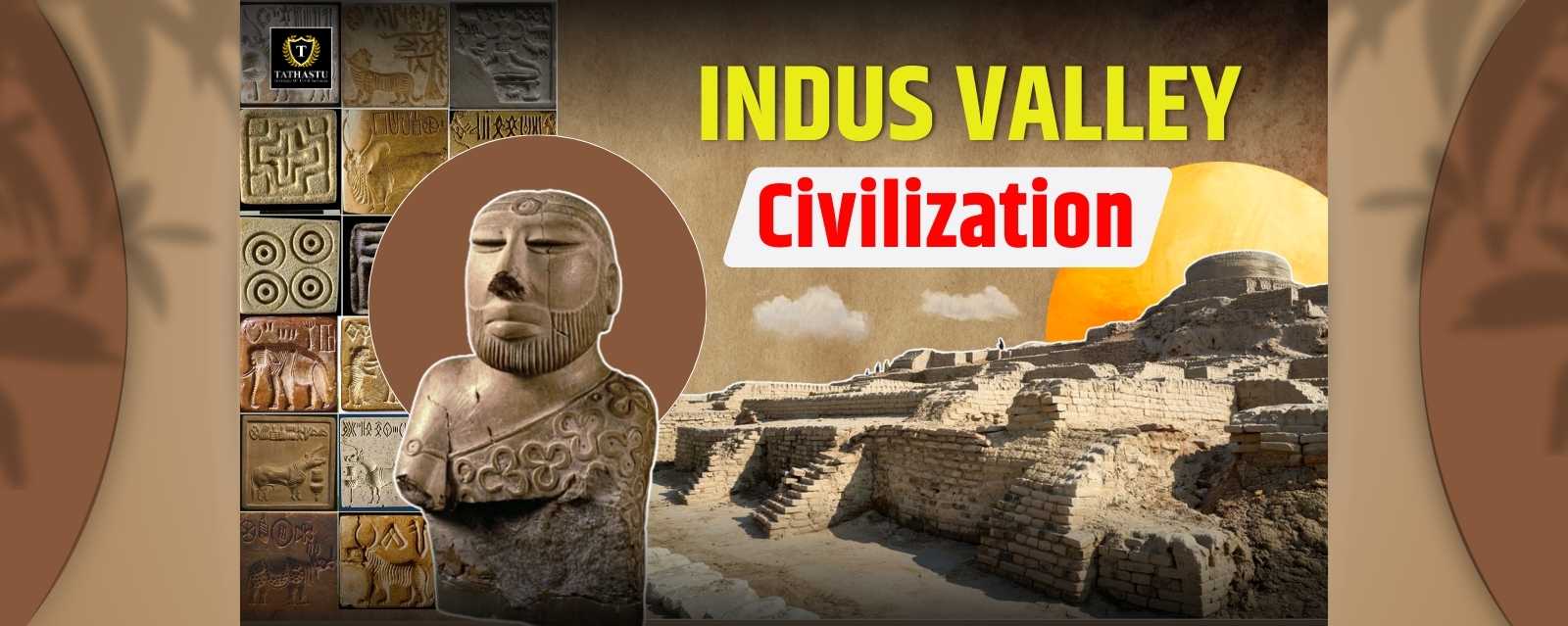About Indus Valley Civilization (IVC)
- Among the world’s most ancient urban settlements stands the Indus Valley Civilization, also known through its name Harappan Civilization.
- The civilization emerged during the 3rd millennium BCE while controlling a huge territory between present-day Pakistan and Afghanistan, and India.
Location and Extent of Indus Valley Civilization (IVC)
The main sites of the Indus Valley Civilization are:
- Harappa (Pakistan)
- Mohenjo-Daro (Pakistan)
- Dholavira (Gujarat, India)
- Lothal (Gujarat, India)
- Kalibangan (Rajasthan, India)
Features of Indus Valley Civilization (IVC)
Some of the key features of Indus Valley Civilization can be seen as follows:
Urban Planning and Architecture
- The urban settlements of the Indus Valley Civilization used plannable street layouts and sophisticated drainage networks, and standardized construction techniques.
- Mohenjo-Daro demonstrates urban planning excellence through its grid-pattern street design, which remains a respected accomplishment in modern times.
- The cities of the civilization exhibited a superior drainage system that utilized underground sewers.
- Each home in the public drainage network received direct connections that preserved sanitary conditions as the main concern.
Economy and Trade
- Wheat, barley, peas, and cotton were the main agricultural products that maintained the IVC economy.
- Pottery, together with jewelry and bead-making marked the skilled craftsmanship of this civilization while a large-scale trade operation prospered.
- The trade network of this civilization reached across distances to Mesopotamia presently corresponds to modern-day Iraq.
- A standardised trade system existed in the Indus civilization as indicated by the discovery of trade weights and seals.
Social Organization
- The IVC shared a well-structured society, yet little knowledge is available about how the political system functioned.
- The absence of significant magnificent structures along with temples implies the civilization may have existed without political leadership or else possibly according to a theocratic social order.
- The Indus Valley Civilization lacks definitive signs of social hierarchy that reveal an established social ranking system between different societal groups.
- The discovery of this possibly indicates that an egalitarian-style society might have existed.
Writing System
- Historians have identified enigmatic writing from the IVC, which people call the Indus Script, but its meaning remains unknown to until today.
- Archaeologists have discovered more than 400 various symbols in seal and pottery artifacts that remain unidentified.
Religion and Rituals
- Archaeological evidence indicates religious practices through the discovered Mother Goddess statues along with religious symbols such as the Swastika.
- Some historical experts propose that religious practices of the IVC incorporated nature worship as well as early expressions of Hindu beliefs because multiple important symbols existed, which later emerged in Vedic traditions.
Technology and Innovation
- Indus Valley people demonstrated advanced expertise in handling copper and bronze, which they combined with their gold working skills.
- Toolmaking, along with weapon production and ornament creation, occurred through their exploitation of these materials.
- Cotton cultivation, along with textile production, which dated back to the earliest times took place within the Indus Valley archaeological region.
- The development of fine pottery used both the potter's wheel together with the wheel as its manufacturing tools.
Decline of Indus Valley Civilization (IVC)
The decline of IVC persists because various explanations continue to develop, including:
- Climate Change stands as a possible reason behind the decline of civilization, according to scholars who discuss how changes in river locations and changing climatic patterns might have reduced monsoon rainfall amounts.
- Different studies suggest natural resource depletion occurred because of excessive farming practices and tree removal, which caused environment-related internal pressures.
- Some researchers present theories about the decline through possible invasions with groups like the Aryans and through internal population shifts, but it lack solid proof.
- The movement of the major Indus River, in addition to its smaller tributaries, might have rendered cities such as Harappa and Mohenjo-Daro obsolete through their dependency on river-based trade and water streams.
Legacy of Indus Valley Civilization
The Indus Valley Civilization left behind an extensive heritage that shaped the subsequent development of all civilizations within the Indian subcontinent. Some lasting aspects include:
- The IVC created highly organized urban designs that would go on to inspire future city planning developments.
- Later Indian kingdoms and empires received their initial trade practices from the Indus Valley Civilization.
- The farming innovations from the Indus Valley Civilization have established agricultural foundations that persist throughout current regional farming techniques.
In conclusion, the Indus Valley Civilization is one of the most advanced and sophisticated civilizations of the ancient world. Despite the fact that there are many mysteries that still surround the civilization, especially regarding its writing system and eventual decline, the IVC made important contributions to urbanism, trade, and craftsmanship that have become enduring legacies. Their legacy can still be seen today within the cultural and social framework of the Indian subcontinent.
